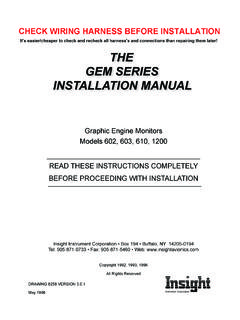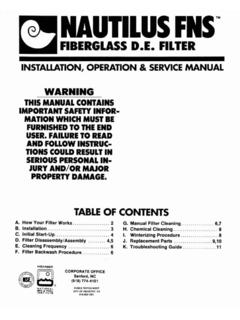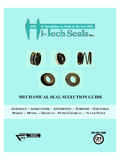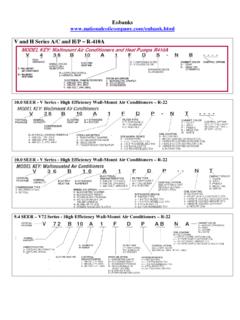Transcription of PRECISION AIRMOTIVE’S - Insight Avionics
1 PRECISION airmotive 'S. MSA FLOAT CARBURETOR. HANDBOOK. (Formally Marvel-Schebler/Facet). &. TROUBLESHOOTING TECHNIQUES. 9/10/2002 Form MSAHBK-1 Revision 1. CONTENTS. NOMENCLATURE PAGE. Section I Introduction 1-1. Section II Description 1-1. Section III Operation 1-2. Operating Instructions 1-4. Section IV Service 1-5. Troubleshooting Charts 2-1. Figures: MA-3 & 4-SPA. Figures: MA-4-5, MA-5. Figures: HA-6. SECTION I. INTRODUCTION. 1. This Handbook covers description, installation, operation, maintenance, and troubleshooting of Float Carburetor models MA-3 and MA-4, MA-4-5, MA-5 and HA-6 as manufactured by PRECISION airmotive Corporation, Marysville, Washington. 2. All material contained in this Handbook applies to all Carburetor Models unless otherwise specified by a particular model. 3. For a listing of Factory Authorized Repair Centers, please see SIL PAC-1, or visit us on the Internet at PRECISION airmotive Product Support may be reached at (360) 651-8282. SECTION II.
2 DESCRIPTION. 1. GENERAL. Models MA-3 and MA-4, MA-4-5, and MA-5 are updraft Carburetors used on Continental, Franklin, and Lycoming Engines. They are of the plain tube, fixed jet type. Models HA-6 are side-draft Carburetors and are used only on Lycoming engines. They are of the plain tube, fixed jet type. 2. DETAILED. (NOTE: The definitions below are of all models of Carburetors in general). a. ACCELERATOR PUMP. This pump is provided with a discharge jet which discharges fuel into the mixing chamber to provide smooth acceleration under all operating conditions. b. MANUAL MIXTURE CONTROL. The Carburetor has a manual mixture control, which adjusts the Carburetor for all throttle positions and loads. It is not normally employed under 5,000 feet msl. c. IDLE SYSTEM. Both primary and secondary idle air vents ensure proper air and fuel emulsion for starting and idling. d. FUEL PASSAGES. Simplified design resists vapor locking of high-test aviation fuel. e. SAFETY THROTTLE LEVER SPRING.
3 This spring holds the throttle in OPEN position for take off in the event of throttle control failure. NOTE: Continental no longer incorporates this spring and has a Service Bulletin, (A2-66), referring to this. f. FUEL INLET STRAINER AND SCREEN. This screen prevents the entry of dirt or foreign matter apt to cause failure. g. VENTS. All air vents open into the main air entrance, which ensures against the entry of dirt into the Carburetor passages or fuel bowl when an efficient air cleaner is used. h. BOWL DRAIN PLUG. The bowl drain plug is located at the lowest point in the fuel bowl and is used to drain water. Page 1-1. SECTION III. OPERATION. 1. PRINCIPLES OF OPERATION. a. IDLE SYSTEM, (Ref. appropriate figure for a particular model). With the throttle fly slightly open to permit idling, the suction or vacuum above the throttle on the manifold side is very high. Very little air passes through the venturi at this time, and hence, with very low suction on the main nozzle, it does not discharge fuel.
4 This high suction beyond the throttle, however, causes the idle system to function as the primary idle delivers into the high suction zone above the throttle. Fuel from the fuel bowl passes through the mixture metering sleeve, fuel channel, power jet, and into the main nozzle bore, where it passes through the idle supply opening in main nozzle, through the idle fuel orifice in idle tube, where it is mixed with air which is allowed to enter idle tube through the primary idle air vent and secondary idle air vent. The resultant rich emulsion of fuel and air passes upward through the emulsion channel, where it is finally drawn into the throttle body through the primary idle delivery opening, subject to regulation of the idle adjusting needle, where a small amount of air passing the throttle fly mixes with it, forming a combustible mixture for idling the engine. The idle adjustment needle controls the quantity of rich emulsion supplied to the throttle barrel, and therefore controls the quality of the idle mixture.
5 Turning the needle counter- clockwise away from its seat richens the idle mixture to the engine, and turning the needle clockwise towards its seat leans the idle mixture. On idle, some air is drawn from the throttle barrel below the throttle fly through the secondary idle delivery opening and blends with the idling mixture to the engine as the throttle is opened, coming into play progressively and blending with the primary idle delivery to prevent the mixture from beginning too lean as the throttle is opened and before the main nozzle starts to feed. These Carburetors are provided with a third and, possibly a fourth idle delivery in addition to the secondary idle delivery, depending on the application to cover the broader idle range in these Carburetors. b. METERING, (Ref. appropriate figure for a particular model). All fuel delivery on idle, and also as steady propeller speeds up to approx. 1,000 rpm, is from the idle system. At approx. 1,000 rpm the suction from the increasing amount of air now passing through primary and secondary venturi causes the main nozzle to start delivering, and the idle system delivery diminishes due to lowered suction on the idle delivery openings as the throttle fly is opened for increasing propeller speeds, until at approx.
6 1,400 rpm the idle delivery is practically nil, and most of the fuel delivery from that point onto the highest speed is from the main nozzle. However, the fuel feed of any full throttle operation is entirely from the main nozzle. The idle system and main nozzle are connected with each other by the idle supply opening. The amount of fuel delivered from either the idle system or main nozzle is dependent on the whether the suction is greater on the idle system or main nozzle, the suction being governed by throttle valve position and engine load. The main nozzle feeds at any speed if the throttle is open sufficiently to place the engine under load, which drops the manifold suction. Under such conditions of low manifold suction at the throttle fly, the main nozzle feeds in preference to the idle system because the suction is multiplied on the main nozzle by the restriction of the venturi. c. ACCELERATOR PUMP, (Ref. appropriate figure for a particular model). The accelerator pump discharges fuel only when the throttle fly is moved towards the open position, and provides additional fuel to keep in step with the sudden inrush of air into the manifold when the throttle is opened.
7 By means of an accelerator pump lever connected to the throttle shaft, the accelerator Page 1-2. pump plunger is moved downward when the throttle is opened, thus forcing fuel past the carburetor pump discharge check valve into the accelerator pump discharge tube which delivers accelerating fuel through the primary venturi into the mixing chamber of the carburetor. Upon closing the throttle, the accelerator pump plunger moves upward, thus refilling the accelerator pump chamber by drawing fuel from the fuel bowl through pump inlet screen and pump inlet check valve. On any quick opening of the throttle the pump follow-up spring yields and thus prolongs the pump discharge sufficiently to prevent slugging the engine with fuel. As a precaution to prevent fuel from being drawn into the mixing chamber when the accelerator pump is inoperative, (any constant throttle position), accelerator pump discharge check valve assembly mounted in the Carburetor is provided with an accelerator pump discharge check valve loaded by an accelerator pump discharge check valve spring.
8 D. POWER ENRICHMENT, (ECONOMIZER), SYSTEM, (Ref. appropriate figure for a particular model).-Aircraft engines are designed to produce a maximum amount of power consistent with their weight. But since they are not designed to dissipate all of the heat the fuel is capable of releasing, provisions must be made to remove some of this heat. This is done by enriching the fuel - air mixture at full throttle. The additional fuel absorbs this heat as it changes into a vapor. Power enrichment systems are often called economizer systems because they allow the engine to operate with a relatively lean and economical mixture for all conditions other than full power. e. MECHANICAL AIRBLEED ENRICHMENT SYSTEM, (Large MA-4-5, HA-6 Carburetors, Ref. appropriate figure for a particular model). When we increase the air velocity through the main venturi, we get an increased pressure drop that enriches the mixture, and to prevent this enrichment, an air bleed of a very precise size is used between the float bowl and the discharge nozzle.
9 If we increase the size of this air bleed, we lean the mixture, and if we decrease it, more fuel is pulled from the discharge nozzle and the mixture becomes richer. The air for the air bleed comes from the float chamber and passes through the air bleed metering valve. The needle for this valve is held off of its seat by a spring and is closed by an operating lever attached to the throttle shaft. When the throttle is wide open, the lever closes the air bleed valve and enriches the fuel air mixture. f. BACK-SUCTION TYPE ENRICHMENT SYSTEM, (Small MA-3, MA-4 Carburetors, Ref. appropriate figure for a particular model). The back-suction mixture control varies the pressure in the float chamber between atmospheric pressure and a pressure slightly below atmospheric. This pressure variation is accomplished by using a control valve located in the float chamber vent line. The float chamber is vented to the low-pressure area near the venturi through a back suction channel. This lowers the pressure in the float bowl.
10 When then mixture control is in the rich position, the vent valve is open and the pressure in the float bowl is raised to essentially the atmospheric pressure, and a differential pressure exists across the main metering jet. This causes fuel to flow out of the discharge nozzle. When the mixture control is moved to lean, it closes the vent valve, and pressure in the float chamber is decreased to a pressure that is essentially the same as that of the discharge nozzle. This decreased pressure differential decreases the flow of fuel. g. MIXTURE CONTROL, (Ref. appropriate figure for a particular model). The mixture control consists of mixture control lever which is attached the mixture metering valve assembly. The mixture metering valve assembly is provided at its lower end with mixture metering valve, which rotates in stationary mixture sleeve. Mixture metering sleeve is provided with a transverse slot through which the fuel enters and fuel metering is accomplished by the relative position between one edge of the longitudinal flat on the mixture metering valve and one edge of the slot in the Page 1-3.









